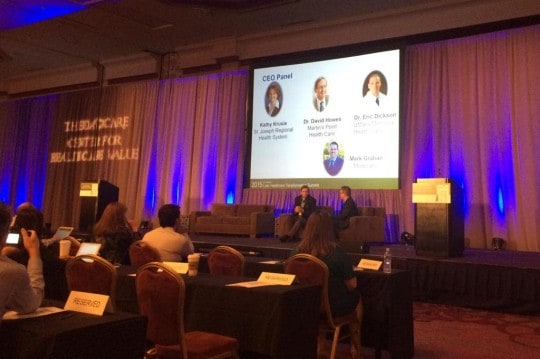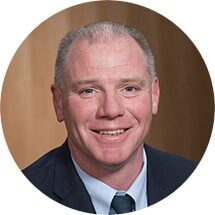Today's guest is Eric Dickson, MD, MHCM, FACEP, the president and CEO of UMass Medical Center.
When Dr. Dickson stepped into the CEO role in 2013, UMass Memorial was in crisis–losing $10 million per month, facing a debt downgrade, and suffering from broken labor relations and mediocre quality scores. Many might have seen Lean as a distraction during such turmoil, but he describes why Lean thinking and Kaizen were exactly the strategy they needed to stabilize and rebuild trust.
Eric shares how the organization defined True North–putting caregivers first to better serve patients–eliminated symbolic hierarchy, prioritized only the most critical A3 projects, and built a system of frontline engagement through daily huddles. By tying leadership compensation to implemented staff ideas and funding innovation directly, UMass began turning crisis into a culture of continuous improvement. His story is a powerful example of leading with respect for people in the toughest of circumstances.
Streaming Player

For a link to this episode, refer people to www.leanblog.org/231.
For earlier episodes of my podcast, visit the main Podcast page, which includes information on how to subscribe via RSS, through Android apps, or via Apple Podcasts. You can also subscribe and listen via Stitcher.

Video of Eric Dickson
Transcript:
Mark: Eric, I've known you since before you came into this role at UMass. Can you describe what the situation was when you took over? You described the organization as being at the brink, which I think it's an unusual place to be.
Eric Dickson: Mark, I became CEO of UMass Memorial Healthcare in February of 2013. It was not an already planned succession. It was a surprise for me. It was the bigger surprise to my wife. It was a time of great turmoil for the organization.
At that moment, we had a minus five percent operating margin, which for us is about a $10 million loss per month. We were very close to defaulting on our publicly traded debt because of something called the debt-service coverage ratio. The accountants in the room will certainly understand what that means.
Moody's got wind of this and downgraded us to the junk bond status, which had a profound impact in our ability to borrow money for anything that we needed to do. For a physician, you learn what that all meant very quickly. It was difficult.
We had a horrible relationship with organized labor, and in my third month at our flagship hospital, the nurses effectively went on strike. We had to empty out the hospital completely. It cost us another $10 million just to bring in replacements for that. That was just because of years and years of a bad relationship between management and nurses.
We had major service issues. Our quality scores were about average, but average quality scores in healthcare are pretty bad – really bad. I had to admit, despite having worked in Lean and been an enthusiast for years, I had to ask the question, is this really the time to roll out a Lean management system?
Mark: What were your first steps? You come into this role as an outsider. You were thrown into this role in this situation. What do you do?
Eric: It was back to basics. We never announced that we were going to institute a Lean program here. We started with things that were inarguable — values, principles, how we were going to do the work. For us, we define True North in the organization is the best place to give care, the best place to get care.
Intentionally, for our caregivers we put “Best place to give care” first. Not that it was more important, but that it was sequential. It was never going to be a great place for our patients until it was a great place for our caregivers.
Then define the role of management as, “We take care of the people who take care of patients, and that's our job.” We did some symbolic things to represent that. We took out all the reserved parking spots that people would walk by every day as they came in to work and moved them to the very back of the parking lot.
We thought about just taking them out completely, but it was more important for us to put them at the very back of the parking lot so that people knew they were there, and those stories started to be told around the organization. We looked for ways of symbolizing this.
We cleared our plate in an exercise of key prioritization. We took everything that people were working on and we built ten A3s, the must-do, can't-fail projects of the year, things that we had to get done. We brought the discipline of A3 thinking to our projects so that we didn't have these déjà vu meetings where we'd come in, and you'd hear about the same problem over and over again, with no clear progress being made on any.
Perhaps most importantly, we built a foundation of engaging everyone, every day, through our huddle system. We made that the base of our Lean program, what was the frontline groups getting together with their manager, going over metrics, primarily in and around the experience of care and the experience of giving care and instituting the frontline staff's ideas.
We set that as one of our True North metrics, the number of ideas implemented, and we tied every manager's compensation, in part, to that.
Mark: What are some of those numbers around the number of ideas being implemented?
Eric: We're at about 20,000 now, at two and a half years in, overall. What we seek is at least one idea, per person, per year that is transferable, that gets registered in the system and is spread. It's not the total number of ideas, but we're looking for great ideas that can help the organization across business units.
Those are the ones that we count right now — registered — and work to spread. We've created a million-dollar innovation fund. A lot of what we've heard from the frontline staff is, “This isn't really important to management. It's a show.”
Then we put a million dollars on it and said, “Ideas from the frontline staff that come through idea system, here's a fund of a million dollars. If a manager tells you he can't do it because we don't have the money, all you have to do is fill out this slip and you get the dollars to implement that,” which really accelerated the program for us.
It's a work in progress. We're happy with the progress but not happy with the results where we're at now.
Mark: I'm curious to hear a little bit more. You talked about some of that, I don't know if it was internal debate with yourself or with others about, “Was the right time for Lean?” What was the counter argument about why that time of crisis would maybe not be the right time for a Lean management system?
Eric: In my first Lean go-live and implementation, it felt like it was all about, “Let's start doing lots of kaizen events and finding efficiencies in the system.” If we had rolled out in that way, bringing a consultant to help you do lots of kaizen events, and these focus things that we were losing jobs because of it, the program would have failed.
The coaching I got was, “What is Lean really all about?” Respect for the people, continuous improvement. Especially the respect for people part, when you're going through a major transformation, is at the core of it. It was not that we don't do kaizen events and that we haven't brought that later. It's that engaging everyone, every day, continuous improvement and doing it in a way that shows respect for people.
One of the defining moments for us is we decided to outsource biomedical engineering. That meant that 13 people were going to have to switch to work for this new company versus working for us. It was hard on them, but it was several million dollars to the organization.
The executive vice president and myself went down and met with those 13 people, looked them in the eyes, explained why we were doing this and told them we were going to do everything we could to ensure that they get the positions in the new company if they wanted, gave them an additional severance.
Even though we had to do something that was hard, and it wasn't Lean-like, we did it in a way that showed profound respect for the people. They weren't happy with the decision, but they thanked us afterward for coming. Even when you have to do difficult things, you constantly ask that question, “Are we doing this in a way that shows respect for other people?” That's an important part of it.
Mark: Are there some ways to think about your own style of leadership that have changed or evolved as you've learned more about Lean and/or now being in the CEO role?
Eric: I'm an emergency physician. I'm used to going into chaos and quickly taking charge, making decisions, and moving forward. I feel like I'm good at it. I spent 20 plus years doing that. I'm still doing it. There is a time for that, and people want leaders to take charge when things are in chaos.
The real key in the long term is to be able to step back and just ask questions and coach. The analogy I gave is training residents. On day one, they come into the emergency department. They're fresh. There's a certain amount of control that I could have, but it's pretty limited. If there's a lifesaving procedure that has to be done, I'm going to keep them very close to me and we might do that.
You watch them grow over time in this first year, particularly graduates, second and third year. At the end, you've got this wonderful physician that you feel confident, if they're in an emergency department, and one of your kids rolls through the door, you'll be comfortable with them taken care of them without you there, over them.
For me, the transition, what I continue to work on is developing those people in the organization the way that we've developed residents for years, so that it's much, much less dependent on me. We've made progress there. I'm watching some people just solve problems in a way they've never solved a problem before, execute at a speed they've never executed before.
It seems like, if I get to the point where I'm just asking questions, I think that's where I'll be most comfortable. That's hard for somebody who came through in the specialty that I came through with.
Mark: You were at the brink. You're now somewhat back from that perilous brink.
Eric: In our first year, we had improvement on all of our quality metrics, especially our big patient safety-oriented metrics, and did $110 million swing in operating performance, which give us some latitude to take the time in making some of the additional decisions.
We spent a long time with the board of trustees focusing on True North metrics, putting patient-oriented metrics always first and the finances at the end. In the first year, in '14, we did well in the finance, did well in the quality, and the board was happy. Our challenge now is some of our quality metrics have slipped in — emergency department of boarding, our number one patient safety issue.
Finances are all green now. I've trained the board, I think, to focus on the quality, and not on the finances, and it's coming back that main way that it should. “You told us this was a number one patient-oriented metric, and we're well off where we wanted to be at this point of the year.” They don't want to talk about the finances.
It's a wonderful transition. It would be more fun to watch somebody else go through it.
[laughter]
Eric: And all of our leaders have focused on that. We've continued to make progress, but it feels very different in terms of governance now. They talk about celebrating the red. The board now knows when something's going off. In every room, it has the metrics posted in there, and the owner posted up for the metric.
The management team now knows when something goes off immediately. There is a heightened sense of, “We need to be dealing with those things. That's the celebration. In the past, our safety metrics could have gone south and nobody would know, or certainly not the board, wouldn't know. They'd be watching the finances.
Please scroll down (or click) to post a comment. Connect with me on LinkedIn.
Let’s build a culture of continuous improvement and psychological safety—together. If you're a leader aiming for lasting change (not just more projects), I help organizations:
- Engage people at all levels in sustainable improvement
- Shift from fear of mistakes to learning from them
- Apply Lean thinking in practical, people-centered ways
Interested in coaching or a keynote talk? Let’s talk.
Join me for a Lean Healthcare Accelerator Trip to Japan! Learn More










